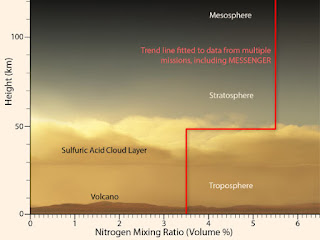When they don't know things about next door to earth....what makes you think they are always right about things in deep space or origins from the mists of time?
Gird up now thy loins like a man; for I will demand of thee, and answer thou me.
Job 38:3
"Despite over 50 years of robotic exploration of Venus, including 13 successful atmospheric probes and landers, scientific knowledge of nitrogen, the second most abundant compound in the Venusian atmosphere, is still uncertain.
To fill this gap, Dr. Patrick Peplowski from the Johns Hopkins University Applied Physics Laboratory and colleagues used data from the neutron spectrometer aboard the MESSENGER spacecraft, which sailed above Venus in June 2007.
When they compared their models with the MESSENGER data, they found the best match was when atmospheric nitrogen made up 5% of the volume, about 1.5 times that measured lower in the atmosphere.
And all of the neutrons came from a region between roughly 60 and 100 km (37-62 miles) above the surface — exactly where there had been the greatest uncertainty.
“That was very much a stroke of luck,” Dr. Peplowski said.
“Why nitrogen increases at higher altitude remains unknown. The discovery raised more than a few eyebrows, .....”
“The notion that there’s a higher nitrogen concentration in the upper atmosphere than in the lower was outside people’s range of thought.”
“We’re still learning fundamental things about Venus and its atmosphere, and it’s our next-door neighbor,” Dr. Peplowski said."
SciNews
Gird up now thy loins like a man; for I will demand of thee, and answer thou me.
Job 38:3
"Despite over 50 years of robotic exploration of Venus, including 13 successful atmospheric probes and landers, scientific knowledge of nitrogen, the second most abundant compound in the Venusian atmosphere, is still uncertain.
To fill this gap, Dr. Patrick Peplowski from the Johns Hopkins University Applied Physics Laboratory and colleagues used data from the neutron spectrometer aboard the MESSENGER spacecraft, which sailed above Venus in June 2007.
When they compared their models with the MESSENGER data, they found the best match was when atmospheric nitrogen made up 5% of the volume, about 1.5 times that measured lower in the atmosphere.
And all of the neutrons came from a region between roughly 60 and 100 km (37-62 miles) above the surface — exactly where there had been the greatest uncertainty.
“That was very much a stroke of luck,” Dr. Peplowski said.
“Why nitrogen increases at higher altitude remains unknown. The discovery raised more than a few eyebrows, .....”
“The notion that there’s a higher nitrogen concentration in the upper atmosphere than in the lower was outside people’s range of thought.”
“We’re still learning fundamental things about Venus and its atmosphere, and it’s our next-door neighbor,” Dr. Peplowski said."
SciNews


